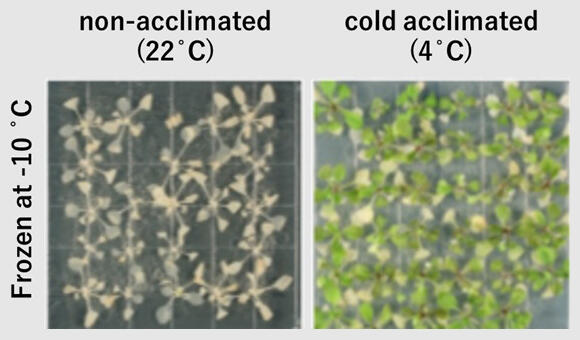A research group led by Assistant Professor Daisuke Takahashi of the Graduate School of Science and Engineering at Saitama University, Professor Kouichi Soga of the Graduate School of Science at Osaka Metropolitan University, and Assistant Professor Satoshi Kidokoro of the School of Life Science and Technology at Tokyo Institute of Technology, in collaboration with La Trobe University (Australia) and the Max Planck Institute of Molecular Plant Physiology (Germany), discovered that β-1,4-galactan, a polysaccharide found in plant cell walls, increases with cold acclimation and improves the freezing tolerance of plants during "winter preparation." In several plant species that can be acclimated to low temperatures and are relatively freeze tolerant, the polysaccharide accumulates in the cell walls after cold acclimation.
In addition to analyzing the structure, the research group also confirmed that freezing tolerance was significantly reduced in Arabidopsis thaliana mutants that have a low accumulation of the polysaccharide. The findings are expected to lead to the future improvement of crop tolerance to low temperatures. The study results were published in the February 8 issue of the international academic journal Current Biology.

Provided by Saitama University
To survive in severe freezing environments, plants in cold regions are believed to undergo "cold acclimation" when they sense a drop in temperature. This process can be thought of as "winter preparation" to increase their tolerance to freezing. The process has been shown to result in the accumulation of glucose and other low-molecular-weight sugars, changes in the lipid composition of the cell membrane, and the accumulation of freeze-resistant proteins. However, changes in the cell wall, which is the outermost cell, were not well understood.
In this study, the research group focused on the polysaccharides that make up the cell wall. These polysaccharides are mainly pectin, hemicellulose, and cellulose, each of which is composed of chains of different monosaccharides. The researchers extracted cell walls from crushed tissues of four vegetables that can be cold-acclimated and are relatively freeze tolerant (pea, spinach, Japanese mustard spinach, and crown daisy). The cell wall polysaccharides were degraded, and their monosaccharide composition was analyzed. Changes after low temperature (4℃) acclimation were examined.
The researchers found that the percentage of galactose (a monosaccharide) in pectin, one of the major polysaccharides in the cell wall, increased after cold acclimation. Galactose is thought to be derived from β-1,4-galactan, a polysaccharide found in the side chain of pectin. Furthermore, when β-1,4-galactan was visualized in the model plant A. thaliana by means of immunostaining, its accumulation was observed to increase throughout the tissues over time during cold treatment. The same results were confirmed by an analysis using a degrading enzyme and glycosidic linkage analysis using gas chromatography mass spectrometry.
It is known that β-1,4-galactan is produced in vivo by the activity of two types of enzymes: galactan synthase (GALS) and UDP-glucose 4-epimerase (UGE). Therefore, the research group investigated changes in the expression of the genes encoding these enzymes upon cold acclimation. They found that the expression levels of the genes increased rapidly upon cold acclimation.
To verify the significance of the accumulation of β-1,4-galactan, freeze tolerance after cold acclimation was studied in an Arabidopsis thaliana mutant in which β-1,4-galactan synthesis is reduced.
The results confirmed that compared with the wild-type strain, the mutants were less tolerant to freezing (-10℃) after cold acclimation. The physical strength of the cell wall in the leaves of cold-acclimated wild-type and mutant plants was examined using a tensile tester. The leaves of the wild-type plants were found to be stiffer and altered. By contrast, the leaves of the mutant strain were unchanged.
The study also suggests the involvement of master transcriptional factors called dehydration-responsive element-binding 1 (DREB1) and C-repeat binding factors (CBF), which are induced by cold acclimation, and the plant hormone abscisic acid (ABA).
Takahashi said, "The phenomenon of an increase in the cell wall component β-1,4-galactan during cold acclimation is thought to be a response seen in a wide range of dicotyledonous plants. If the understanding of the detailed physiological functions associated with β-1,4-galactan can be enhanced on the basis of our findings, the possibility of using it to modify stress tolerance in various plants will become apparent. Additionally, based on our understanding of the effects of climate change on plants, we would like to focus on the process by which cold acclimation is lifted by rising temperatures in the future."
Journal Information
Publication: Current Biology
Title: Structural changes in cell wall pectic polymers contribute to freezing tolerance induced by cold acclimation in plants
DOI: 10.1016/j.cub.2024.01.045
This article has been translated by JST with permission from The Science News Ltd. (https://sci-news.co.jp/). Unauthorized reproduction of the article and photographs is prohibited.




